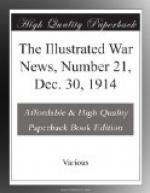_______________________________________________________
___________________ THE ILLUSTRATED WAR NEWS, DEC. 30, 1914—[Part 21]—35
[Illustration: HEADQUARTERS UNDERGROUND: THE BRAIN OF THE BRITISH ARMY WORKING IN A SUBTERRANEAN ROOM, SAFE FROM SHELL-FIRE.]
Our illustration shows how and why the motive-power of the Expeditionary Force, the brain of the Army, is often to be found below-ground. Mr. John Dakin, writing of this drawing, made by him from a sketch which he made at the Front, says: “Throughout the war, the enemy has displayed considerable skill in locating and shelling any buildings selected for occupation by our Staff. Various methods of countering these tactics have been devised. On at least one occasion, headquarters was established in a subterranean apartment, which was not merely bomb-proof, but a comfortable retreat from the weather. Here, by lamplight, plans were worked out; scraps of information pieced together with the aid of maps without risk of interruption from the enemy.”—[Drawn by John Dakin from his Sketch made on the Spot.]
_______________________________________________________
___________________ 36—THE ILLUSTRATED WAR NEWS, DEC. 30, 1914.—[Part 21]
[Illustration: AFTER THE ENEMY HAD BEEN ALLOWED TO COME WITHIN POINT-BLANK RANGE OF THEIR SILENT FOE:]
Determined night-onslaughts by infantry have been, according to a letter from Petrograd, a notable feature of the German tactics in the battles on the Vistula, particularly in the fighting that has been taking place between Lowicz and the river. By day, the Germans, we are told, were persistently aggressive, continuously launching attacks against various points of the Russian lines, while the Russians remained on the defensive. With the coming of darkness, however, regularly, night after night, the Germans redoubled their efforts everywhere, taking advantage of the obscurity to fling forward dense swarms and columns of men in massed formation, to storm the entrenched Russian position, apparently at any cost. They failed every time, it would appear, beaten back after literally a massacre. The Russian tactics, it is interesting to recall, were
_______________________________________________________
___________________ THE ILLUSTRATED WAR NEWS, DEC. 30, 1914—[Part 21]—37
[Illustration: RUSSIAN INFANTRY SMASHING A GERMAN NIGHT-ATTACK IN MASSED COLUMNS, IN A BATTLE ON THE VISTULA.]
exactly the same as those with which, as our own officers and men have described in letters home, Sir John French’s battalions in every case so effectively shattered the German efforts at breaking through the British during the retreat after Mons. The Russians, it is stated, invariably allowed the Germans to come in to well within point-blank range, remaining silent, holding their fire and not showing a light meanwhile. Then, as the enemy got within point-blank range, searchlights were suddenly switched on and a ceaseless fusillade of Maxim and rifle-fire from the Russians literally mowed the Germans down by hundreds, breaking up their masses and paralysing the attack. Our illustration shows one of the combats just at the critical moment.—[Drawn by Frederic de Haenen.]




